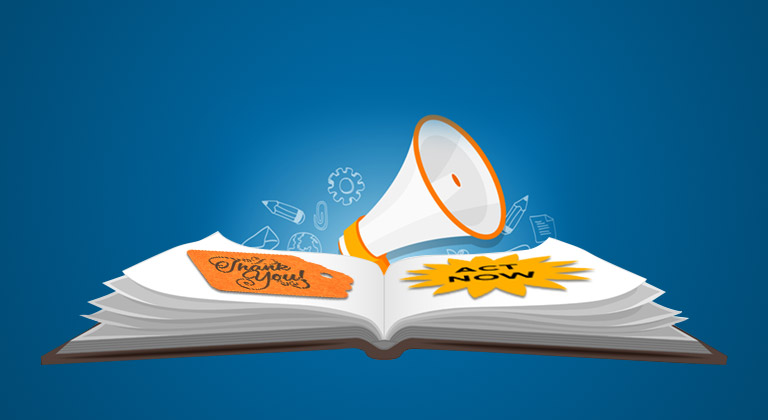Why Your Back Matter Matters
With any luck, the final page of your book has left your reader eager for more. But how do you make sure they find that next fix immediately, before their attention is pulled away to something else? This is why back matter – the material in the final pages of your book – is so important to the organic growth of your writing career. But you can’t, and shouldn’t, drop just anything back there. The trick is including the most effective content needed to achieve your publishing goals without breaking any rules.
There’s a long list of things I wish I’d known before I started trying to launch a self-publishing career, so even though I worry that I’m explaining the obvious when I make posts like this, I’m hoping somebody finds value in them – I know I would have, a few years ago.
Today, I want to talk about the basics. We write about launch strategies, advertising campaigns and all sorts of other marketing stuff – but before you jump into any of that, it’s time to look at the basics. How can you build your reader base organically? Without having to spend a penny?
Well, the answer is by writing books that people love – and then giving them a way to read more and find out more in the back of your book.
When a reader turns to the next page after THE END, you should have additional material to help readers find your other work – and links so they can get it! Plus, links to your mailing list, website, and anywhere else that gives them an opportunity to continue their relationship with you beyond the end of the story.
What is back matter?
Back matter is anything you place into your book following the end of your tale. If you’ve ever read a book before – especially an eBook – you definitely know what I’m talking about. Sometimes the first thing you’ll see will be a link to an author’s mailing list, other times it’ll be a catalog of their other books, plus the Author’s Notes and acknowledgements. Some authors even include sample chapters of their next work – or even entire stories (that’s often referred to as ‘stuffing’ – more on that later.)
The goal here is to engage with your reader and help move them from this book onto the next one in your catalog (and, hopefully, other books beyond that.) You want to turn a reader into a fan; and your back matter is the easiest and most immediate way of doing that.
Below are some things to think about when deciding what to add in terms of back matter – and I hope you find this information useful.
The rules – and stuffers!
Before we even begin to explore back matter, it’s worth talking about the rules. As you know, Amazon has a million rules – most infuriatingly vague – and one of the more recent ones is the rule that only 10% of your published book’s length can be used for back matter or ‘bonus material.’
As is the origin of most rules, this one came about as an answer to a practice that Amazon wanted to snuff out. Due to the introduction of ‘page reads’ – where authors enrolled in KDP Select were paid based on the number of pages a reader read as opposed to just a flat cost for the entire book – shysters soon realized that they would get paid for a ‘page read’ no matter whether the page a reader finished on was part of the book they’d bought… or one of any of the pages that followed. This led to a phenomenon called ‘stuffing’ in which authors would publish their book… and place another book right after it… and another… and another…
Some books were literally thousands of pages long; with authors including not just their latest book, but sometimes every book of theirs they’d written prior to that.
In terms of book sales, this was a dumb idea – because why give a reader all your books for the price of one instead of trying to get them to pay for each one individually – right?
Except in certain genres – romance especially – there are so many readers who are part of Kindle Unlimited that authors earned far more from page reads than book sales (I write romance, and I earn about $5 in page reads for every $1 I make in book sales.) Since the page read rate is paid based on number of pages read regardless of number of books they are in, an author who managed to get a reader to churn through ALL of their written works in a single, over-stuffed title was paid just as much as an author who had a reader borrow and read each of their books individually.
And since getting a reader to buy one book is a lot easier than relying on them to remember to return and buy each one separately, the practice became a no-brainer for many authors. For over a year this practice of ‘stuffing’ became so ubiquitous that even mainstream self-published authors began doing it to remain competitive (full disclosure here – I used to add significant ‘bonus material’ in my erotic shorts for the same reason.)
Fortunately (or unfortunately, for those making bank off this scheme) there was a growing movement among readers to push back against this practice of ‘stuffing’, and many authors supported that. Because while they focused on writing the next book in their series, the ‘stuffers’ were eating their lunch by scamming page-reads with over-stuffed books.
(To be fair, though, the issue eventually became a lot worse than authors just adding ‘bonus books’. There were stories of some authors just adding nonsense text, or pasting the same book over and over again, just to inflate their page reads. And while you may believe that wouldn’t matter since readers would just not bother reading through all of that garbage, other scams evolved to deal with that, such as placing enticing links at the front of books that would redirect the reader all the way to the final page.)
As a result, Amazon came up with the rule that only 10% of your book can be in the form of back matter – so this is something you should be aware of when considering your own options. For most authors, this limitation isn’t an issue – but if your eyes lit up at the thought of all those extra page reads, consider this your warning.
Remember the Amazon philosophy – if it makes for a bad reading experience, you probably shouldn’t do it. Overstuffed books don’t add a lot to a reader’s experience.
Authors can have their books unpublished or even lose their accounts if they’re caught ‘stuffing’ – but for anybody stressing out about it, I have good news.
First, as far as I’m aware, the only way Amazon knows that this rule has been broken is if a reader takes it upon themselves to report a book as ‘stuffed.’ This means that you’re unlikely to fall foul of this rule unless you break the Amazon philosophy and have so much back matter that it creates a bad reading experience (one readers will actually make the effort to complain about.)
The second piece of good news is that the 10% rule is a little more flexible when it comes to books that are published as bundles, multi-book compilations, or similar options that inherently have to have more than one book in them. The way to cover yourself here is to make it clear and unequivocal on the product page of your book what the reader can expect to find within the pages.
So if you do have titles with additional bonus material that extends well beyond 10% of the book’s length – in short, if you are or have ever been a ‘stuffer’ – then you still have an opportunity to go and republish all your books so they don’t contain this stuff. Trust me, even if your offending book hasn’t been noticed thus far, it’s much better to fix the issue proactively rather than wait for Amazon to come to you!
Links to your other books
Now let’s talk about the stuff you can add that won’t get you in trouble with Amazon!
Links to your other books is the obvious first choice.
If a reader has finished your entire book, that’s a good sign – so keep that momentum going by having links to any other books that you’ve written. When reading on a Kindle, or eReader, this gives the reader a chance to go straight to your product page on Amazon and buy the next book in your catalog. All they need to do is tap the link.
I tend to take thumbnail screen grabs of my books and insert them into my manuscript with links directly to the book’s product page on Amazon, along with hot-linked titles and a short little blurb to wet the reader’s appetite. One of the best pieces of advice I received is to preface that with a link to my author page on Amazon – because when you publish new books, they’ll appear on Amazon so you won’t have to go back and update the back matter of each of your previously-published books to reflect the new ones.
It’s fairly self-explanatory, but there are a couple of things you need to keep in mind:
You can’t use affiliate links.
If, like me, you have an Amazon Affiliate link, you’re probably posting that everywhere! There was a time when I used to make upwards of $100 a month just from the affiliate fees I’d receive. However, Amazon has really been cracking down on that recently – and their TOS states that you can’t use affiliate links on social media, in email communication, or the back matter of your books. Just have a straight link to your book – otherwise Amazon will be able to follow the source of each affiliate click and will instantly know you’re breaking the rules.
And if you don’t think Amazon cares about authors breaking this particular rule, keep in mind that even Mark Dawson inadvertently fell afoul of this with one email communication he sent out. So Amazon is definitely paying attention, at least if the volume of clicks is high enough.
One link or many?
The amazing thing about Amazon’s self-publishing platform is that it enables you to sell books all over the world without leaving your home. When you publish a book on Amazon.com, it’ll automatically be published on all other Amazon platforms you selected, like Amazon.co.uk in Britain, and Amazon.com.au in Australia.
The problem is, a British customer can’t buy your book from the Amazon.com link, and vice-versa. If you’re trying to appeal to a global audience, you’ll run into an obstacle when you’re faced with only one URL to insert, but dozens of potential countries you want people to buy your book in.
One option is to list individual links to each book – US link, UK link, and Australia link (and as many others as you’d like.)
The alternative is to use a third-party service like smartURL to do that for you. Smart URL will create a unique link for you which will then redirect people to different locations depending on their IP address. If you click on the link in the United States, for example, it will take you to Amazon.com. If you’re in the UK, that same URL will redirect you to Amazon.co.uk.
Another advantage is that you can CHANGE the destinations at smartURL, so you can republish a book with a different ASIN without having to go into the back matter of your currently published books and change it to the new link.
While that sounds great, a lot of people have complained that smartURL links are blocked by certain ISPs, and certain firewalls – so definitely do some investigation before you commit to this plan of action. A link to Amazon.com for a British reader is better than no link at all!
Links to your Mailing List
A mailing list is one of the most essential components of any self-published author’s strategies – and your back matter is the perfect place to stick a hotlink to your Mailchimp or other email list management service. While you won’t get a huge number of signups organically, you’ll always get some – and the good thing about subscribers you get organically as opposed to those you pay for with an advertising campaign is that they’re already ‘warm’ leads – they wouldn’t have signed up if they didn’t like your book!
I recommend the same strategy as you use with any paid subscriber list-building: Offer an incentive, like a free book or ‘reader magnet’, to make the appeal of signing up even more… um, appealing?
Links to your Social Media / Website
Another no-brainer that it nevertheless took people like me a while to grasp is the idea of throwing your social media links into your back matter. I include links to my author page on Amazon, my Twitter and Facebook pages, and my website. Again, while you might not get a massive influx of new followers – you’ll get some; and they’ll be warm leads who already like your book.
Author’s Notes / Acknowledgements
For me, the most fun part of publishing a book is taking a few hours to write a note in the back of my book, explaining my motivations and inspirations for writing this particular tale, and thanking those who helped me bring it to life (like my editor and ARC readers.) I’ve never been convinced that many people actually read these Author’s Notes pages – but when a reader does, it’s normally an instant way to make a connection with them. Some of my most loyal fans are those who messaged me about something I wrote in my Author’s Notes section, because it highlights why the book resonated with them.
Bonus Material
In the opening of this article, I warned about ‘stuffing’ books – but for somebody like me, who tends to write on the longer side (my last novel was 150,000 words) there is still a lot of room within that 10% limit to include other useful things. Good recommendations are a ‘sample chapter’ of another book – with a link to click straight through to the product page at the end of it!
If you’re good at the opening paragraph of a book (this tends to be the acid test for a successful reader) you can get a lot of new readers this way; by making it easy for them to ‘flow’ from the book they just finished reading into the next one in your catalog. For readers with Kindle Unlimited, especially, this is a powerful ploy because it costs them nothing to ‘borrow’ the next book in the series; but you still get paid for them reading it.
If nothing else, this also forces you to look critically at the opening chapters of your book to see if they grab a reader quickly enough. The moment I started using this technique, all my books started having punchy first chapters – and that let to a much higher number of readers in general, because more of them got swept up into my book.
I tend to include any bonus chapters right after the end of the previous book – before my Author’s Notes or anything else – because that’s when you’re most likely to grab a reader’s attention and have them transition from one book to the next most easily.
Conclusion
There are so many moving parts to self-publishing – especially when you’re new at it, and uncertain of best practices. While nothing about building out your back matter requires the intellect of a brain surgeon, it’s certainly something I neglected for the first few years of my publishing career, and I probably delayed what success I had by failing to embrace this step.
Take your back matter seriously, and you’ll see that time and effort repaid many times over; and snowball in impact as the reach of your books expand. As an independent author in charge of your own marketing, this is one of those steps you can’t afford to skip!












3 Comments